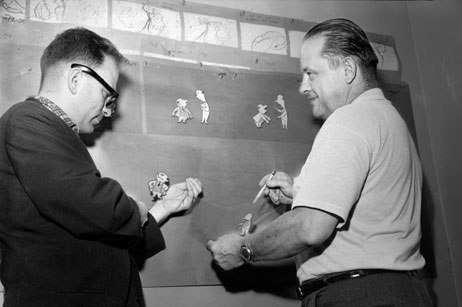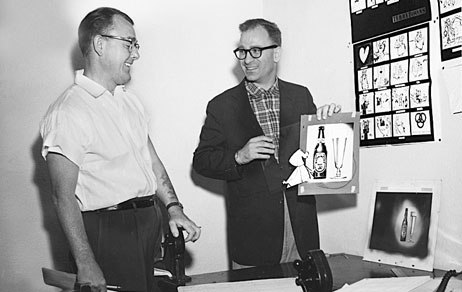Terrytoons. Here was my locale that most interests the animation historians. So now I finally have the chance to tell it like it really was. I name names -- all the names, and print the pix. And all the production details about Tom Terrific. I tell you what I did and what I tried to do - a "renaissance" - a total make over... and I tell you why it failed.
On the following pages are model sheets of some of the characters I created at Terrytoons, for which I had unfulfilled high hopes. For all of these, I made the original model sketches. Some of them were later refined by my key designers. "Dewitt Clinton Clobber" was my personal highest hope, and I drew all of the model sheets of him myself. Gaston Le Crayon went through several stages of development, with the final model drawn by Eli Bauer.
John Doormat also evolved, with Al Kouzel coming up with the final model, and directing his best film, "Another Day, Another Doormat," of which I am still very proud to have nurtured. On all of these characters, we tried very hard to develop in a multi-dimensional way, writing extensive character studies of each of them. Part of the John Doormat character outline is reproduced here. It's from early 1957.
The Sidney model sheet was drawn by me. Foofle, the precursor of my later Nudnik character, was developed by me, but this production model sheet was drawn by Larz Bourne, Terrytoons best traditional gagman and storyboard artist.
I'm proud to have been the first to bring the work of R.O.(Bob) Blechman to animation production, with his charming and incisive rendition of "The Juggler of Our Lady." It was a great gas to put his tiny scribbly characters onto the huge CinemaScope screen! A few frames are reproduced here.
After the model sheets are some notes on the people of Terrytoons during my time there.
Here are the entire personnel of CBS Terrytoons during my tenure:
STORY
T. Morrison
E. Bauer
L. Bourne
J. Feiffer
J. Simek
DIRECTION & LAYOUT
C. Rasinski
A. Bartsch
A. Kouzel
D. Tendlar
E. Pintoff
R. Favata
MUSIC
P. Scheib
BACKGROUNDS
B. Hilliker
B. Focht
COLOR MODELS
P. Popper
ANIMATION
E. Davis
J. Tyer
E. Donnelly
J. Gentilella
L. Silverman
Chiarito
B. Kuwahara
V. Bell
P. Breese
ASS'T ANIMATORS
R. Sancier
M. Taracka
D. Fern
B. Ackerman
SUPERVISION
W. Gleason
CHECKING
Tasadfoey
S. LaBounty
P. Guilano
ANIMATION CHECKING
T. Martini
ASS'T PAINT TECH
A. Booker
INKERS OR TRACERS
A. Ambrose
C. Anzilotti
J.Lautenslaker
T. Guadagno
M. Hurley
J. Aurichio
C. Higgins
J. Paratore
M. McLoughlin
J. Roettcher
A. Steindecher
M. Acquiviva
G. Tylersmith
PAINTING
R. Bakshi
R. Rossburg
C. Hall
J. Workman
R. Diggs
D. Stone
OFFICE BOY
J. Foster
E. Reavis
CAMERA
J. Rasinski
D. Moye
G. Davis
T. Moskowitz
EDITING
G. McEvoy
J. McConnell
S. Greco
R. Corelli
E. Wolfson
SOUND EFX
T. Dockstader
SHIPPING & RECEIVING
J. Schuck
CHAUFFEUR
Geronimmo
MAINTENANCE
A. Bauer
OFFICE
G. Johnson
N. Alberti
J. Davis
P. Ryan
A. Teitell
J. Cammerato
V. Petersen
ADMINISTRATIVE
W. Weiss
G. Deitch
P. Terry
F. Schudde
B. Boyd
SALES OFFICE
N. Schwin
G. Eskowitz
Connie Rasinski. One of the old-timers, and probably one of those initially resentful of an outsider being brought in to become creative chief, and one of the most difficult to convince that I was doing the right thing for Terrytoons. But Connie was a capable, professional director, and he did much good work for me.
Phil Scheib. On the basis of the old Terrytoons I had seen, I assumed that I would be stuck with cornball hack musician, and I would have to find a way of sneaking in other composers if I wanted anything musically decent. However, after some nervous contact on both sides, I found Phil to be a real pro. I was able to release him from Terry's imposed limitations, and he ultimately created some great melodies and great scores for our new characters! Only on a couple of commercial projects we undertook did I feel the need of an outside composer. I got to like and admire Phil, and I remember him fondly. The rotten music for earlier Terrytoons was really Paul Terry's fault. In early sessions, Phil told me that when he had created what he felt were fine orchestral arrangements, Paul would sit in the recording studio booth, and when he heard that there were passages where the strings played, then they rested while the brass played, and so on, he was furious. Terry shouted, "I am paying for 30 musicians, and I want those 30 musicians to be playing all the time, not resting on my money!" he shouted. And that was the origin of those muddled and over-busy musical scores typical of the early Terrytoons!
Tommy Golden. A good animator. His animation of our test Bert & Harry Piels commercial helped me bring this account to Terrytoons from UPA.
Ernie Pintoff. Ernie was a gifted, but temperamental eccentric. He liked to sit in his little room and play jazz trumpet for inspiration, thus rattling the nerves of other nearby animators.
Bob Kuwahara. A very talented animator, who later directed his own series, featuring a Japanese character, I think was called "Hashimoto."
Dave Tendlar. A gentle and likeable veteran.
Art Bartsch. Basically the creator of Mighty Mouse. Art was a skillful director and one of the best draftsmen in the studio.
Larz Bourne. One of my favorite people in the studio, a long-time member of the story department. Larz was the most prolific of the classic animation gag creators. I felt him to be a sympathetic gentleman, and he came through for me with terrific Clobber and Gaston material.
Jim Tyer, one-of-a-kind animator. In the dead-hand roster of Terrytoons animators, Jim was the odd-man out. He didn't hold to models; he did quirky, eccentric actions; he didn't stick to the numbing norms of Paul Terry's regime. In other words, he was exactly what I was hoping against hope to find in that stodgy arena. Jim did amazing things with my elephant character, "Sidney," and with "Tom Terrific, and "Flebus." Sometimes his animation was weird, but it was always inventive, and always funny. In a 1981 article, Will Friedwald summed up well, my relationship with Jim. I quote part of it here:
"Deitch brought with him many UPA methods and concepts. Many of the Terrytoon old-timers must have resented what seemed like bold and radical changes at the time, but it was just the opposite with Jim Tyer. That was because, in a sense, Tyer had been working in the "UPA style" all his life. Instead of doing the usual Disney/Hollywood type of animation that most American animators of the Thirties and Forties were expected to do, Tyer's animation had always tried to caricature real life movement rather than imitate it. This was the point that UPA and Deitch tried to stress, not only in their animation, but in their design and layout as well. Tyer would have fit in well with UPA-Hollywood or UPA-New York, and when Deitch tried to turn Terrytoons into "UPA-New Rochelle" it was just as well.
For one of the first times in his life, Tyer was not only permitted to draw and animate in his wildest fashion, but actually encouraged to. For once, he didn't have to wait until the less creative minds who ran the studios were looking the other way to draw the way he wanted. He could take it as far as he wanted with Deitch's blessing. "My father and Jim got along fine," said Gene Deitch's son, Simon, "and they made some good pictures together. He often said that Jim was the most flexible of the older guys at Terry's." The picture one gets of Tyer at this point is vastly different from the Tyer who stubbornly refused to change his style at Famous a decade earlier. Tyer had matured both as an animator and a human being. Deitch also insisted on giving animators the full screen credits they deserved, which Terry had, of course, never done. Tyer's name appeared on the screen for the first time since he had left Famous.
Deitch assigned Tyer to work on an idea for a new series starring a "neurotic elephant" character. The character was originally called "Sick Sick Sidney," which was the title of the first cartoon in the series (in which Tyer animated several scenes), but the name was soon changed to "Silly Sidney." It turned out to be Deitch's single most successful effort at Terry's. Although they came up with at least half a dozen new characters, only Sidney is remembered today. "They put him to work on Sidney," artist Doug Crane reminisced,...It was just beautiful what he did with that character, Sidney. Almost everybody in the studio loved it; it just seemed like the most incredible thing."
Tyer worked on some of Deitch's other projects as well, most notably the character "Clint Clobber," and the highly successful TV show "Tom Terrific," but it didn't last long. There were bad feelings between Deitch and Bill Weiss, the "official" businessman who had ultimate control of Terrytoons. It was decided by Weiss and CBS to revert back to Terry's original idea of "the cartoon as mass-produced product" rather than Deitch's meticulous care for each individual film. Deitch was out by mid-1958, and Tyer left on November 18 of that year. With Deitch gone, the studio was going "limited" the same way that Paramount had already gone. In fact, it looked like New York animators would be turning out limited animation from here on out. Tyer had no reason to stick around."
Will Friedwald
R.O. Blechman. Bob of course was not a member of the studio; quite the opposite. He was the most hard-to-get talent I ever went after. I was dying to do his "Juggler of Our Lady" from the moment I saw the book. I spent night after night on the phone with him for nearly a year, trying to persuade him to let us do the film, but the schlock reputation of Terrytoons had turned him off. He was a shy, seemingly remote and strange fellow, with a nervous, bashful smile, but hard as nails concerning the integrity of his work. Finally I succeeded. I promised him my most advanced staffer, Al Kouzel, to be the nominal director, and that I would personally oversee the project to ensure absolute fidelity to his book. Here is where Phil Scheib also came through for me, creating a classic baroque music track. My greatest inspiration for this film was to get Boris Karloff to narrate. I had heard him do classic roles on the radio, and I wanted to present him out of type, as the gentle, literate man he really was. It was a pleaure working with him, and the film turned out to be my highest achievement at Terrytoons. I am proud that I was the first to bring R.O.Blechman to the screen.
Ralph Bakshi. During my time at TT, Ralph was the lowest of the lowly, a minor cel painter, and not a very good one. But in the democratic studio atmosphere I was creating, he took full advantage of his right to nose around, ask questions, and put in his opinions. He had a lot of brass and a lot of moxie. I began to notice that he was always tailing me around, trying to learn everything that was going on. Almost immediately after I left, Weiss tagged him as a potential replacement for me, and the rest is history. Ralph really shot up the ladder, and became the enfant terrible of the animation world.
My fondest memory from Terrytoons was the excitement of having such a neat job - the chance to do something big, trying to remold a studio with the worst possible reputation, having the 20th Century-Fox CinemaScope release, having the chance to create new characters, having so many people working on concepts that I was creating and directing, developing an entire new way of doing soundtracks for animation movies, with the help of Tod Dockstader. He was not only a terrific artist and gagman, but a genius sound man.. All of this great fun blinded me to the realities...
I was out of Terrytoons about May, 1958, and was then present at the birth of a new studio in Manhattan, with the intriguing name, Gene Deitch Associates, Inc.
























